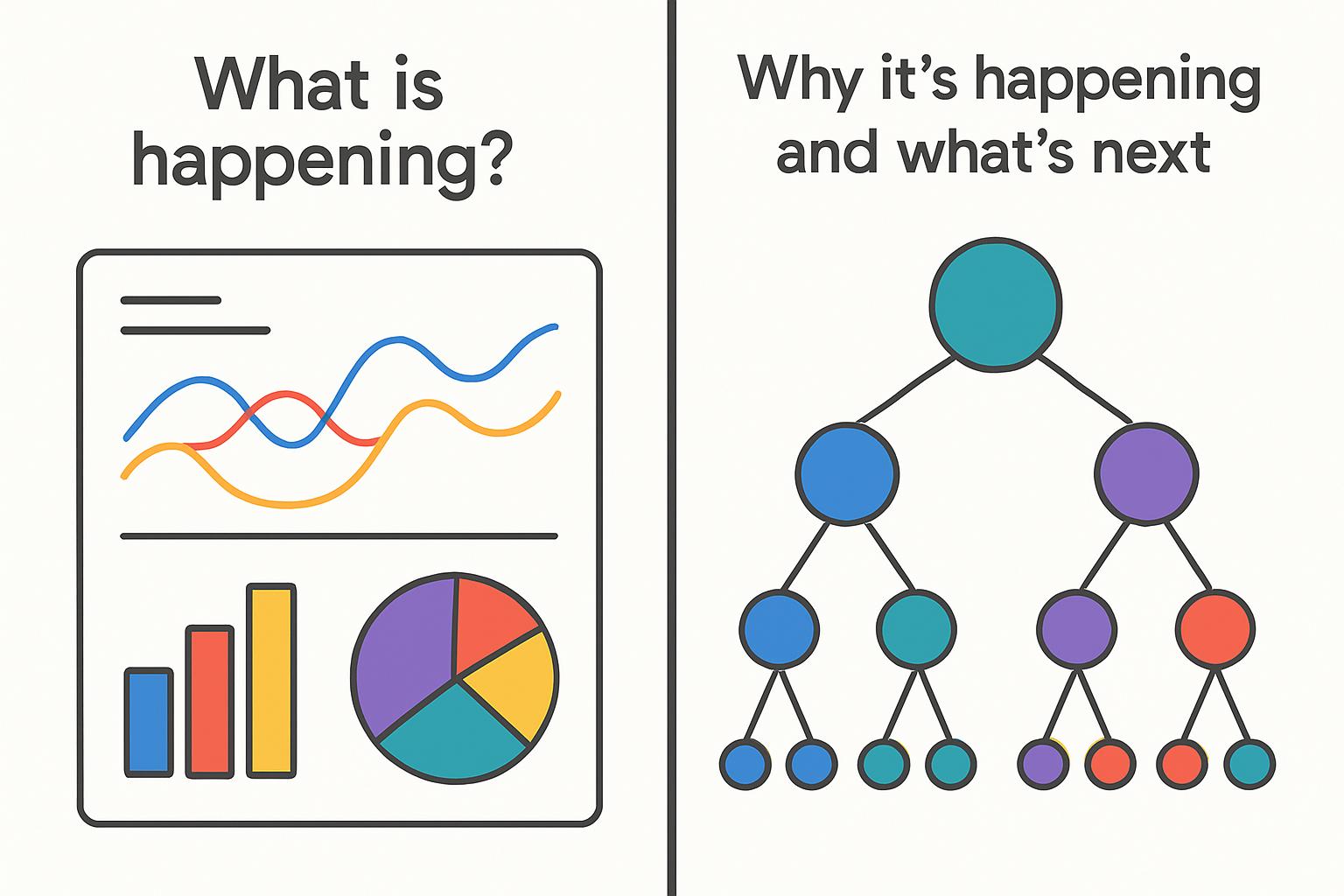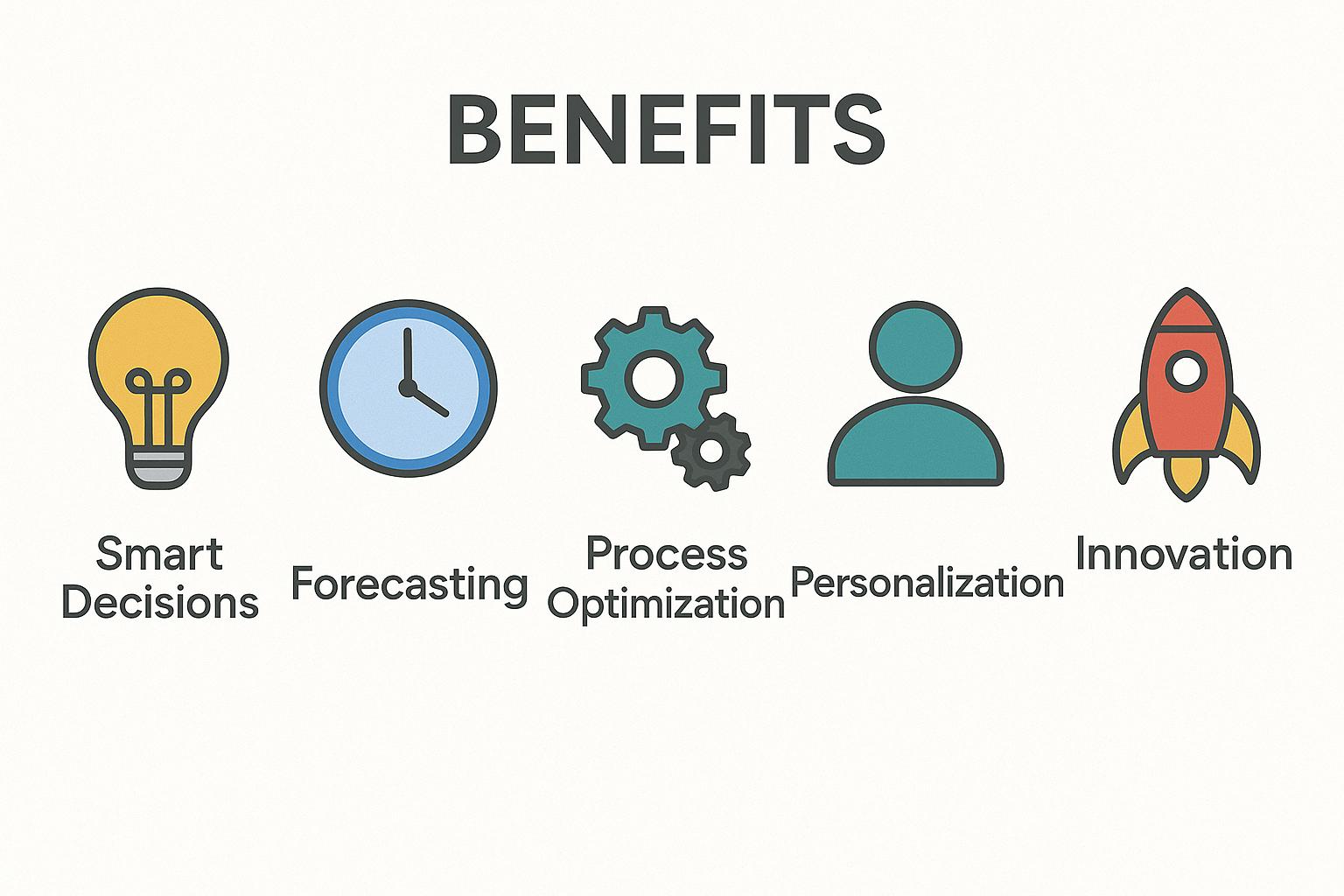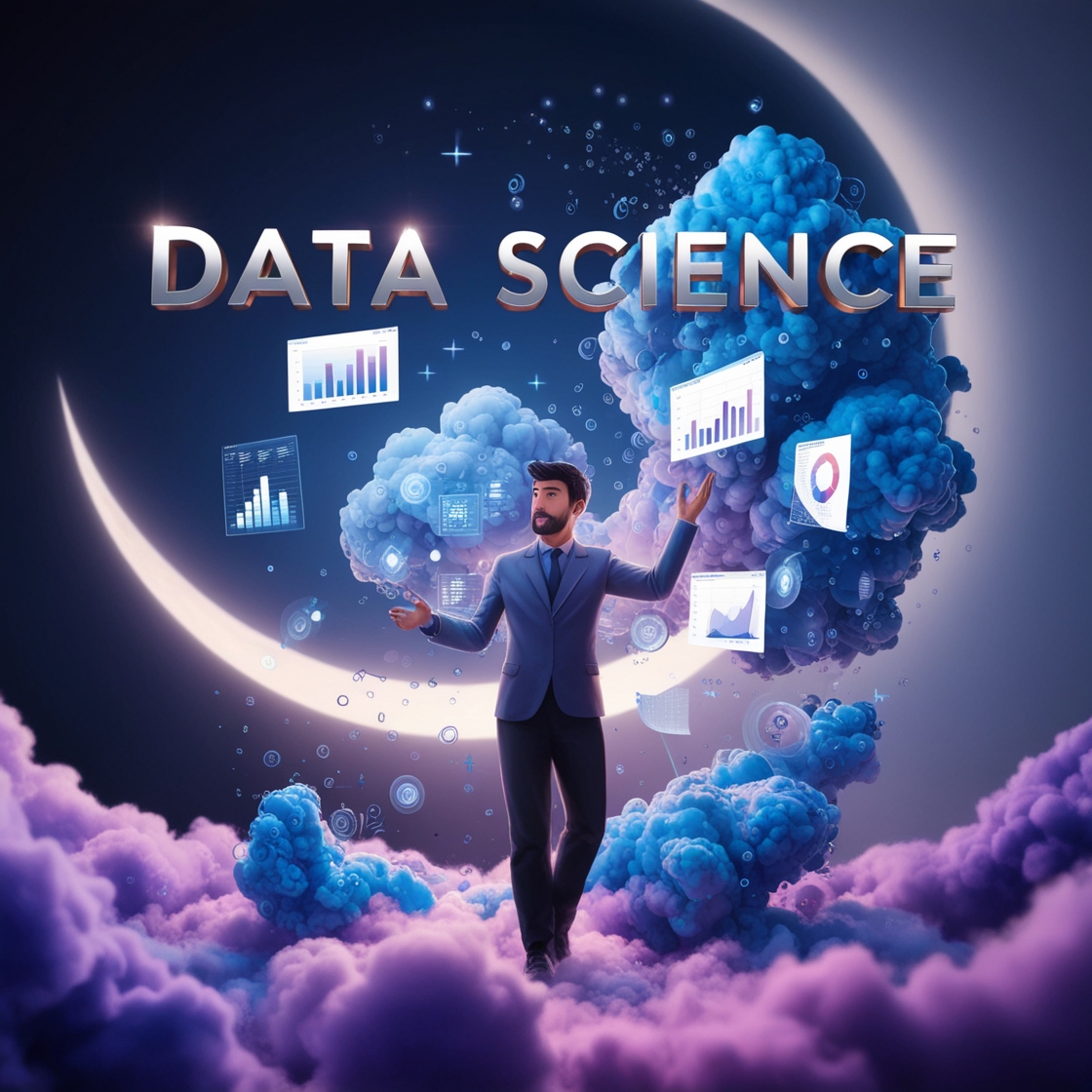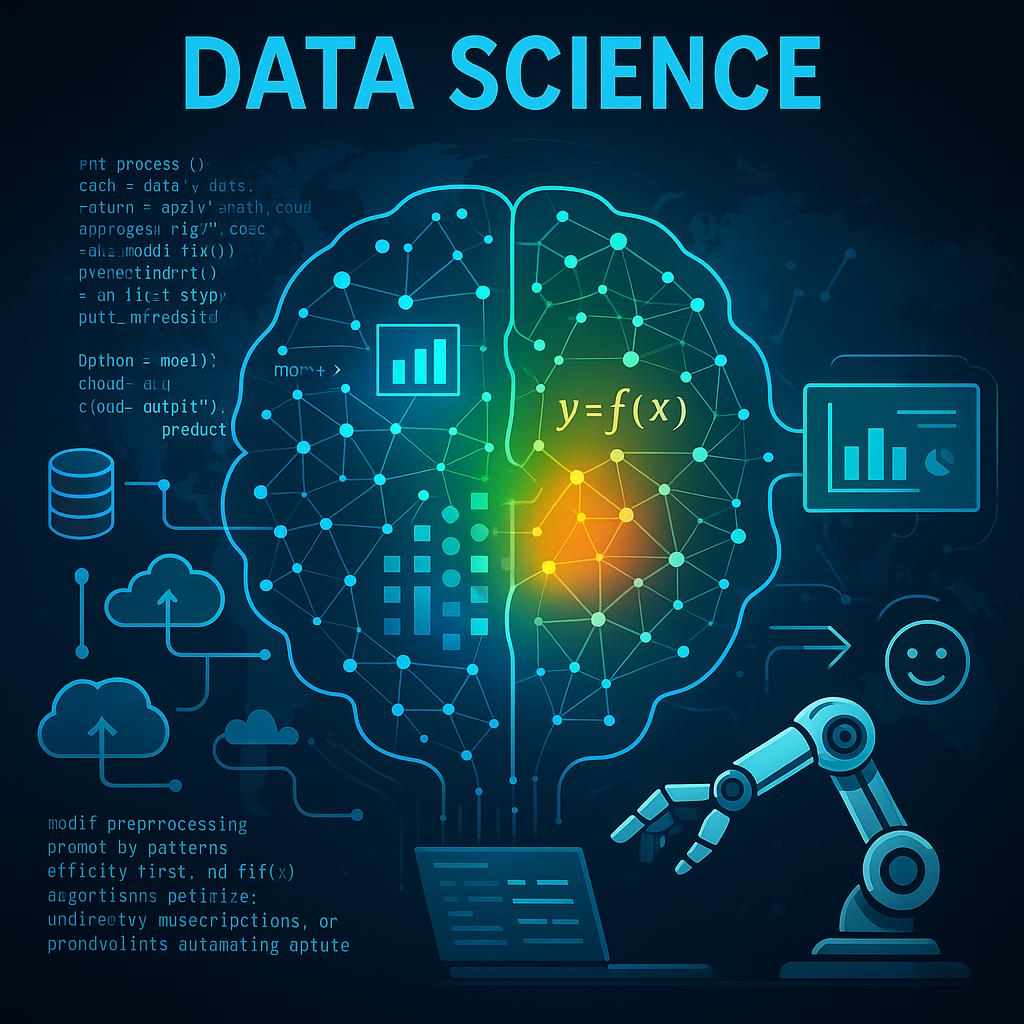Introduction
Data science has become a disruptive force at the nexus of innovation, business, and technology. For businesses negotiating complexity and competition, what was formerly a field of academic research and experimental modeling has evolved into a strategic imperative. Data science enables businesses to make better, quicker, and more assured decisions in a big data-driven environment, from personalizing customer journeys to optimizing product launches.

This progress is particularly potent because of the smooth transition between machine learning, statistical reasoning, and data analytics. Data science goes deeper than data analytics, which turns unstructured data into insightful patterns and dashboards. It identifies hidden linkages, connects those patterns to sophisticated models, and employs algorithms to anticipate and automate results. This all-encompassing strategy enables companies to gain truly meaningful insight and go beyond superficial metrics.

Previously guided by experience and intuition, data-driven methods are increasingly revolutionizing industries. Machine learning models are used in healthcare to help with early diagnosis and therapy planning. Algorithms for detecting fraud protect financial transactions in real time. A/B testing, segmentation, and behavioral modeling are tools used in marketing that enable campaigns to be precisely tailored. All of this is made possible by data scientists who use their coding skills, subject knowledge, and analytical frameworks to make a meaningful difference.
However, the adoption of data science is not just happening in tech-forward industries. Even more established sectors, such as woodworking, textiles, and agriculture, are starting to adopt data-centric thinking. No longer are there exceptions, such as a local producer forecasting seasonal demand using sales data or a farmer modifying fertilizer amounts based on predictive yield models.
They are a reflection of a broader trend: modernization through data science without sacrificing uniqueness or workmanship.
IoT, cloud computing, and real-time data pipelines are examples of emerging technologies that are speeding up this shift. These tools allow data scientists to create models that simulate, optimize, and even automate business choices by feeding large datasets into analytical ecosystems.
What is the outcome? A change from reactive to proactive reporting, driven by intelligent systems.
In the end, rather than whether companies get data, the question is whether they can comprehend and use it efficiently. Data science can help in this situation. It turns raw inputs into knowledge, potential into performance, and confusion into clarity. Leading in the digital age requires a strategic mentality, not just a set of technical talents.
If businesses already have dashboards, why do they still need data science?
Dashboards display the current situation, but data science explains why, how, and what should happen next. Although data analytics tools and visualisations offer a glimpse of corporate performance, including operational delays, customer attrition, and sales patterns, they frequently just scratch the surface. Though they reveal relationships, they hardly ever foresee results or validate causality. Data science is really useful in this situation.

Beyond reporting, data science employs a combination of statistical models, machine learning techniques, and domain-specific insights. Through experimentation and simulation, it explores possible solutions, forecasts future behavior, and pinpoints the underlying causes of trends. Data scientists turn unprocessed data into evidence-based recommendations by using techniques including regression analysis, categorization models, and time-series forecasting. This assists companies in making decisions that are both proactive and reactive, reducing risk, optimizing opportunity, and avoiding change.
Companies run the danger of misinterpreting patterns, emotionally responding to transient changes, or failing to notice important but subtle signals hidden in their data if they don’t use data science. Simply put, data science is crucial for determining what matters most and for influencing what happens next, even while dashboards are great at displaying what is.
Benefits of Data Science in Business

1. More Intelligent Decision-Making Based on Data
Organizations may make strategic decisions based on insights rather than conjecture thanks to data science. It gives decision-makers the confidence to act by revealing patterns, outliers, and connections in intricate datasets. All departments, from supply chain and operations to marketing and finance, make choices more quickly, accurately, and impartially as a result.
2. Forecasted Knowledge for Upcoming Planning
Predictive analytics is one of data science’s most potent contributions. Businesses are able to predict demand, consumer behavior, and market volatility by using models based on both historical and current data. Companies may anticipate difficulties, lower uncertainty, and plan proactively rather than reactively with the aid of this forward-looking aptitude.
3. Efficiency and Process Optimization
Data science facilitates operations by automating repetitive tasks, detecting inefficiencies, and modeling workflows. Companies may increase efficiency, minimize downtime, and optimize resource allocation by using strategies like clustering, decision trees, and anomaly detection, particularly in manufacturing, retail, and logistics.
4. Improved Knowledge of and Customization for Customers
Personalized client experiences are largely made possible by data science. Data scientists may segment audiences, forecast needs, and customize services to increase customer satisfaction, loyalty, and conversion rates using tools like sentiment analysis and recommender systems. It transforms unprocessed behavioral data into real-time, actionable insights.
5. Innovation and a Competitive Edge
Data science stimulates innovation by uncovering hidden trends or unmet market demands. It helps businesses test new product concepts, model consumer reactions, and use data to improve go-to-market tactics. Businesses that use these insights have a distinct advantage over those that continue to rely solely on intuition.
Challenges and Solutions in Data Science
Despite its enormous potential, data science is difficult to apply in practice. Businesses frequently struggle to get the most out of their data science investments due to misplaced expectations between technical and business teams and fragmented data systems. But every obstacle offers a chance for improvement, expansion, and more robust data-driven cultures, particularly with the help of knowledgeable data scientists and wise planning.

Challenge 1: Inadequate Data Infrastructure and Disjointed Sources
Well-structured data pipelines and interconnected systems are lacking in many businesses. The creation of trustworthy machine learning models is hampered, and insight production is constrained when data is fragmented, out-of-date, or inconsistent.
Solution:
Spend money on cloud storage, ETL tools, and contemporary data architecture that automate preprocessing and integrate data sources. Data scientists and data engineers work across functional boundaries to guarantee that data is clean, accessible, and prepared for analysis.
Challenge 2: Limited Understanding Among Stakeholders
Business teams often rely on dashboards or metrics without fully grasping the assumptions and limitations behind data science models. This can lead to misinterpretation, unrealistic expectations, or resistance to adopting insights.
Solution:
Promote data literacy across departments. Offer workshops that explain AI concepts in practical terms. Encourage communication between data scientists and stakeholders through clear visualizations and storytelling to connect analysis to business impact.
Challenge 3: Misapplication of Models and Algorithms
Using the wrong algorithms or misinterpreting results can lead to flawed decisions. Examples include deploying biased models, skipping cross-validation, or mistaking correlation for causation.
Solution:
Establish best-practice frameworks for model selection, validation, and testing. Build diverse teams with both technical and domain expertise. Peer reviews, reproducible code, and continuous evaluation reduce the risk of misuse.
Challenge 4: Opposition in Manual or Conventional Sectors
Concerns about complexity or loss of control may make people hesitant to use automation or artificial intelligence in industries like manufacturing, crafts, or agriculture.
Solution:
Begin with use cases that give quantifiable gains that are low risk and high visibility, such as scheduling, pricing, or inventory optimization. Before expanding, use trial projects to establish credibility and demonstrate measurable results.
Challenge 5: Ethical Issues and Model Interpretability
Black boxes can form from complex models like ensemble methods or neural networks. Concerns about compliance, transparency, and trust are raised when stakeholders are unable to comprehend the decision-making process.
Solution:
Use model simplification, SHAP, LIME, and other explainable AI (XAI) approaches. Select interpretable models as needed, particularly in sectors with strict regulations like healthcare and banking. When designing, always keep bias reduction, ethical considerations, and fairness in mind.
Examples of Data Science in Practice in the Healthcare Sector
Healthcare
Data science is transforming the way patients are treated in contemporary healthcare systems. Hospitals identify patients who are at risk of worsening by using real-time monitoring and predictive models. By using electronic health records to train machine learning algorithms, early intervention, better treatment plans, and even AI-assisted diagnoses are made possible, which improves outcomes while cutting costs.
Retail
Retailers use data science to tailor promotions, improve inventory, and predict customer demands. Businesses can improve pricing methods and provide individualized marketing by using strategies like A/B testing, consumer segmentation, and recommendation systems. Data scientists estimate demand and avoid stockouts or overstocks by analyzing behavioral data and purchasing history.
Energy
Data science is used in the energy sector to increase reliability, sustainability, and efficiency. Simulation models that estimate supply, balance load demand, and optimize distribution are fed real-time data from wind and solar farms in renewable energy systems. Algorithms for predictive maintenance also assist in locating malfunctioning parts before they result in outages.
Farming
Thanks to data science, smart farming is now a reality. To improve crop rotation, fertilization, and irrigation, farmers employ AI-driven yield prediction models, sensor data, and satellite imagery. In addition to increasing yield, these tools lessen their negative environmental impact and resource waste.
Engineering and Construction
Data science is applied in the construction industry for risk assessment, cost forecasting, and project scheduling. The probability of delays, cost overruns, or shortages of materials can be indicated using predictive analytics. When combined with IoT devices and BIM (Building Information Modeling), data science increases site safety and planning accuracy.

Conclusion
In today’s commercial world, data science has become one of the most revolutionary skills. It is no longer optional to be able to decipher meaning, predict consequences, and make evidence-based judgments in a world where information is abundant. Companies from all industries are now more concerned with how to use data efficiently than with whether to use it at all. Real-time, data-driven decision-making is made possible by the advanced techniques and mentality of data science, which turns disjointed information into clarity.
A hybrid thinker who combines technical fluency, business acumen, and analytical rigor, the data scientist is at the center of this shift. These professionals do more than just create models; they also help firms confidently handle uncertainty, offer order to chaos, and link insights to action. Data science enables companies to shift from reactive to proactive—and even predictive—strategies, whether it is through the diagnosis of system inefficiencies, customer behavior prediction, or future scenario simulation.
Traditional sectors are also realizing the benefits of data science. Small-scale manufacturers, suppliers, and service providers are discovering that data is not just the purview of tech behemoths. In a rapidly evolving environment, they may also increase productivity, enhance customer satisfaction, and maintain their competitiveness with easily accessible tools and focused applications. The potential uses of data science will only increase with the development of automation, AI, and machine learning.
Data science is ultimately a strategic facilitator of corporate transformation rather than just a technological discipline. It infuses creativity with insight, decision-making with intellect, and execution with speed. Future markets will be led by those that embrace data science now, with assurance, clarity, and quantifiable impact, in a time when success is defined by agility, personalization, and foresight.


